Developing and Implementing a Successful Mentoring Program Plan
VerifiedAdded on 2023/01/16
|40
|11606
|42
Project
AI Summary
This assignment outlines a comprehensive plan for designing and implementing a mentoring program, covering all key stages from initial planning to final evaluation. The project begins with a pre-planning phase, emphasizing the need for a thorough needs assessment and stakeholder engagement analysis to ensure program relevance and support. It then details the development of the program, including communication strategies and the program's structure, such as defining the purpose, identifying the target mentee type, and setting clear goals. The plan further addresses mentor/mentee recruitment and selection processes, including criteria, promotional materials, and matching procedures. The assignment also explores ongoing maintenance and support mechanisms, as well as a detailed evaluation plan to measure program outcomes, collect data, and disseminate findings. Finally, it considers program alignment with relevant legislation and data management practices. The aim is to provide a structured guide for organizations seeking to establish effective mentoring initiatives.

Running head: PLAN AND IMPLEMENT A MENTORING PROGRAM
Plan and implement a mentoring program
Name of the student:
Name of the university:
Author note:
Plan and implement a mentoring program
Name of the student:
Name of the university:
Author note:
Paraphrase This Document
Need a fresh take? Get an instant paraphrase of this document with our AI Paraphraser
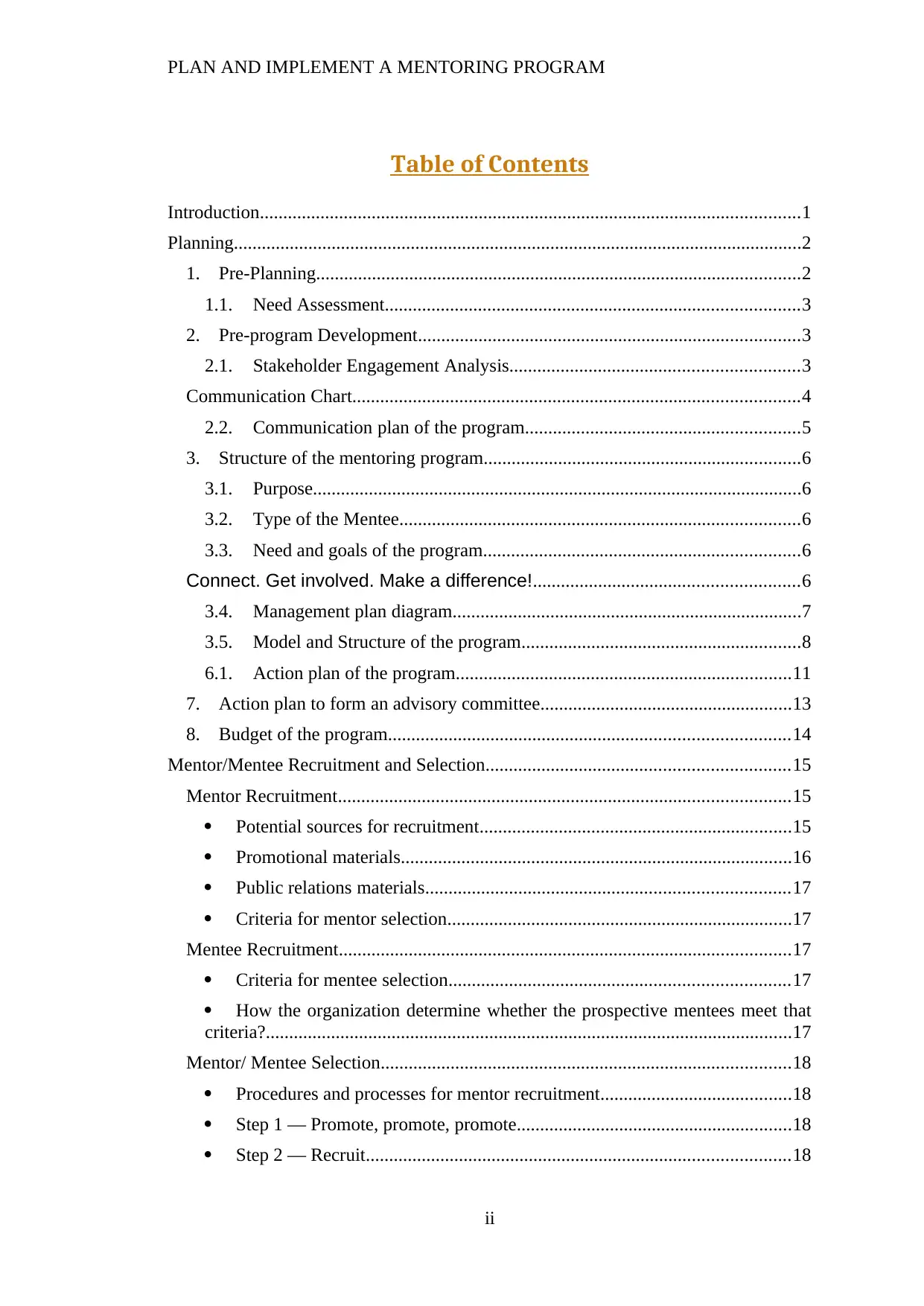
PLAN AND IMPLEMENT A MENTORING PROGRAM
Table of Contents
Introduction....................................................................................................................1
Planning..........................................................................................................................2
1. Pre-Planning........................................................................................................2
1.1. Need Assessment.........................................................................................3
2. Pre-program Development..................................................................................3
2.1. Stakeholder Engagement Analysis..............................................................3
Communication Chart................................................................................................4
2.2. Communication plan of the program...........................................................5
3. Structure of the mentoring program....................................................................6
3.1. Purpose.........................................................................................................6
3.2. Type of the Mentee......................................................................................6
3.3. Need and goals of the program....................................................................6
Connect. Get involved. Make a difference!.........................................................6
3.4. Management plan diagram...........................................................................7
3.5. Model and Structure of the program............................................................8
6.1. Action plan of the program........................................................................11
7. Action plan to form an advisory committee......................................................13
8. Budget of the program......................................................................................14
Mentor/Mentee Recruitment and Selection.................................................................15
Mentor Recruitment.................................................................................................15
Potential sources for recruitment...................................................................15
Promotional materials....................................................................................16
Public relations materials..............................................................................17
Criteria for mentor selection..........................................................................17
Mentee Recruitment.................................................................................................17
Criteria for mentee selection.........................................................................17
How the organization determine whether the prospective mentees meet that
criteria?.................................................................................................................17
Mentor/ Mentee Selection........................................................................................18
Procedures and processes for mentor recruitment.........................................18
Step 1 — Promote, promote, promote...........................................................18
Step 2 — Recruit...........................................................................................18
ii
Table of Contents
Introduction....................................................................................................................1
Planning..........................................................................................................................2
1. Pre-Planning........................................................................................................2
1.1. Need Assessment.........................................................................................3
2. Pre-program Development..................................................................................3
2.1. Stakeholder Engagement Analysis..............................................................3
Communication Chart................................................................................................4
2.2. Communication plan of the program...........................................................5
3. Structure of the mentoring program....................................................................6
3.1. Purpose.........................................................................................................6
3.2. Type of the Mentee......................................................................................6
3.3. Need and goals of the program....................................................................6
Connect. Get involved. Make a difference!.........................................................6
3.4. Management plan diagram...........................................................................7
3.5. Model and Structure of the program............................................................8
6.1. Action plan of the program........................................................................11
7. Action plan to form an advisory committee......................................................13
8. Budget of the program......................................................................................14
Mentor/Mentee Recruitment and Selection.................................................................15
Mentor Recruitment.................................................................................................15
Potential sources for recruitment...................................................................15
Promotional materials....................................................................................16
Public relations materials..............................................................................17
Criteria for mentor selection..........................................................................17
Mentee Recruitment.................................................................................................17
Criteria for mentee selection.........................................................................17
How the organization determine whether the prospective mentees meet that
criteria?.................................................................................................................17
Mentor/ Mentee Selection........................................................................................18
Procedures and processes for mentor recruitment.........................................18
Step 1 — Promote, promote, promote...........................................................18
Step 2 — Recruit...........................................................................................18
ii

PLAN AND IMPLEMENT A MENTORING PROGRAM
Step 3 — Match.............................................................................................19
Step 4 — Guide.............................................................................................19
Selecting the mentor that fit to the established criteria.................................19
Form for mentee enrolment into the program...............................................20
Mentee/Mentee orientation............................................................................21
Matching......................................................................................................................25
1. Pre-matching.....................................................................................................25
1.1. Criteria for matching..................................................................................25
1.2. Matching the mentor and mentee...............................................................26
2. Kick-off meeting...............................................................................................28
3. Ongoing maintenance and support....................................................................28
3.1. Mechanism for getting regular feedback from mentors and mentees........29
Evaluation....................................................................................................................31
1. Evaluation plan to measure the outcomes.........................................................31
2. Process for data collection................................................................................31
2.1. Time to collect the data..............................................................................31
2.2. Collection methods....................................................................................32
2.3. Evaluating the collecting data....................................................................32
3. Review structure of the program and how the outcomes will be disseminated 34
4. Align the program to the legislations and keeping of data................................35
4.1. Keeping the collected data.........................................................................35
References.....................................................................................................................iv
iii
Step 3 — Match.............................................................................................19
Step 4 — Guide.............................................................................................19
Selecting the mentor that fit to the established criteria.................................19
Form for mentee enrolment into the program...............................................20
Mentee/Mentee orientation............................................................................21
Matching......................................................................................................................25
1. Pre-matching.....................................................................................................25
1.1. Criteria for matching..................................................................................25
1.2. Matching the mentor and mentee...............................................................26
2. Kick-off meeting...............................................................................................28
3. Ongoing maintenance and support....................................................................28
3.1. Mechanism for getting regular feedback from mentors and mentees........29
Evaluation....................................................................................................................31
1. Evaluation plan to measure the outcomes.........................................................31
2. Process for data collection................................................................................31
2.1. Time to collect the data..............................................................................31
2.2. Collection methods....................................................................................32
2.3. Evaluating the collecting data....................................................................32
3. Review structure of the program and how the outcomes will be disseminated 34
4. Align the program to the legislations and keeping of data................................35
4.1. Keeping the collected data.........................................................................35
References.....................................................................................................................iv
iii
⊘ This is a preview!⊘
Do you want full access?
Subscribe today to unlock all pages.

Trusted by 1+ million students worldwide
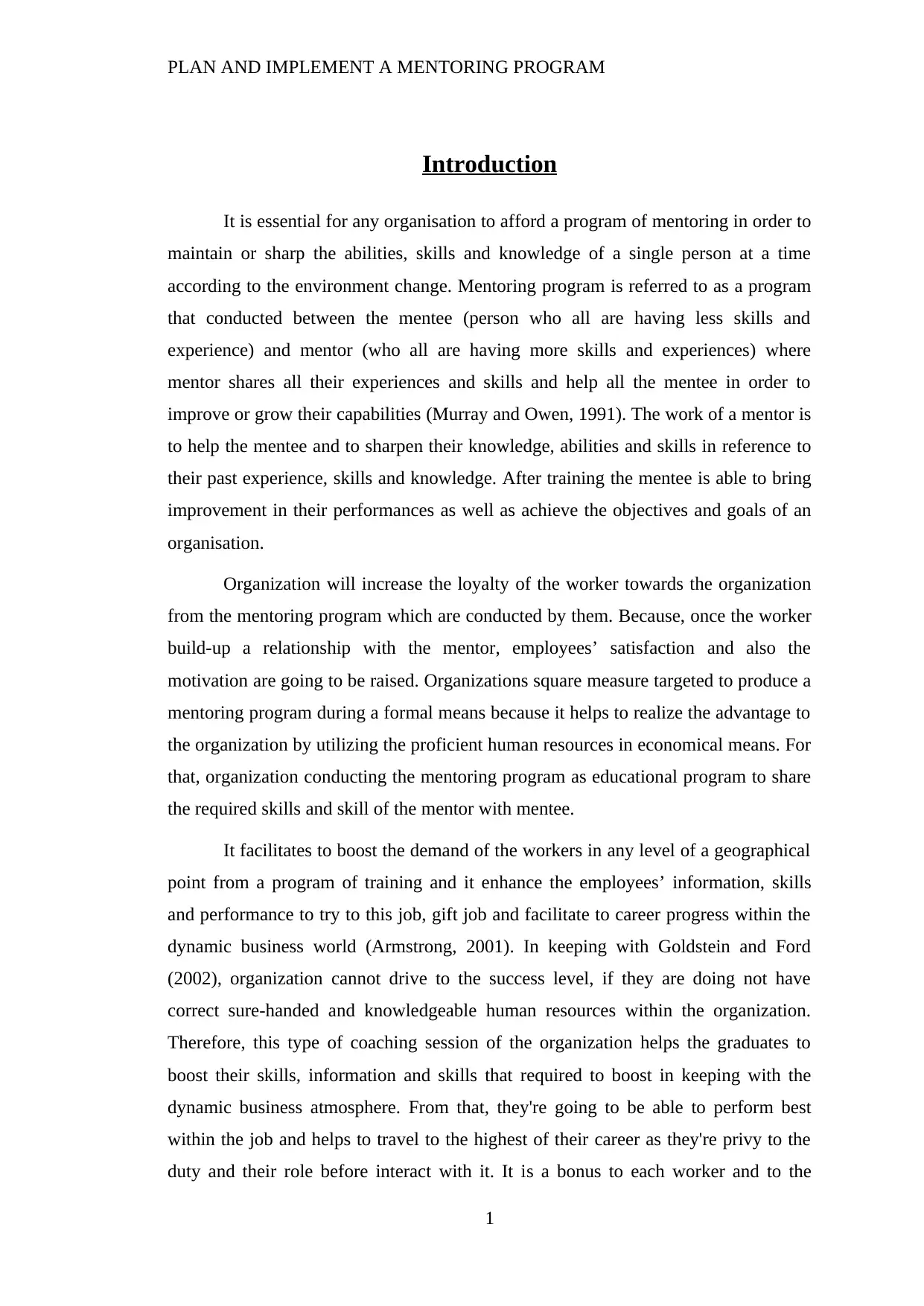
PLAN AND IMPLEMENT A MENTORING PROGRAM
Introduction
It is essential for any organisation to afford a program of mentoring in order to
maintain or sharp the abilities, skills and knowledge of a single person at a time
according to the environment change. Mentoring program is referred to as a program
that conducted between the mentee (person who all are having less skills and
experience) and mentor (who all are having more skills and experiences) where
mentor shares all their experiences and skills and help all the mentee in order to
improve or grow their capabilities (Murray and Owen, 1991). The work of a mentor is
to help the mentee and to sharpen their knowledge, abilities and skills in reference to
their past experience, skills and knowledge. After training the mentee is able to bring
improvement in their performances as well as achieve the objectives and goals of an
organisation.
Organization will increase the loyalty of the worker towards the organization
from the mentoring program which are conducted by them. Because, once the worker
build-up a relationship with the mentor, employees’ satisfaction and also the
motivation are going to be raised. Organizations square measure targeted to produce a
mentoring program during a formal means because it helps to realize the advantage to
the organization by utilizing the proficient human resources in economical means. For
that, organization conducting the mentoring program as educational program to share
the required skills and skill of the mentor with mentee.
It facilitates to boost the demand of the workers in any level of a geographical
point from a program of training and it enhance the employees’ information, skills
and performance to try to this job, gift job and facilitate to career progress within the
dynamic business world (Armstrong, 2001). In keeping with Goldstein and Ford
(2002), organization cannot drive to the success level, if they are doing not have
correct sure-handed and knowledgeable human resources within the organization.
Therefore, this type of coaching session of the organization helps the graduates to
boost their skills, information and skills that required to boost in keeping with the
dynamic business atmosphere. From that, they're going to be able to perform best
within the job and helps to travel to the highest of their career as they're privy to the
duty and their role before interact with it. It is a bonus to each worker and to the
1
Introduction
It is essential for any organisation to afford a program of mentoring in order to
maintain or sharp the abilities, skills and knowledge of a single person at a time
according to the environment change. Mentoring program is referred to as a program
that conducted between the mentee (person who all are having less skills and
experience) and mentor (who all are having more skills and experiences) where
mentor shares all their experiences and skills and help all the mentee in order to
improve or grow their capabilities (Murray and Owen, 1991). The work of a mentor is
to help the mentee and to sharpen their knowledge, abilities and skills in reference to
their past experience, skills and knowledge. After training the mentee is able to bring
improvement in their performances as well as achieve the objectives and goals of an
organisation.
Organization will increase the loyalty of the worker towards the organization
from the mentoring program which are conducted by them. Because, once the worker
build-up a relationship with the mentor, employees’ satisfaction and also the
motivation are going to be raised. Organizations square measure targeted to produce a
mentoring program during a formal means because it helps to realize the advantage to
the organization by utilizing the proficient human resources in economical means. For
that, organization conducting the mentoring program as educational program to share
the required skills and skill of the mentor with mentee.
It facilitates to boost the demand of the workers in any level of a geographical
point from a program of training and it enhance the employees’ information, skills
and performance to try to this job, gift job and facilitate to career progress within the
dynamic business world (Armstrong, 2001). In keeping with Goldstein and Ford
(2002), organization cannot drive to the success level, if they are doing not have
correct sure-handed and knowledgeable human resources within the organization.
Therefore, this type of coaching session of the organization helps the graduates to
boost their skills, information and skills that required to boost in keeping with the
dynamic business atmosphere. From that, they're going to be able to perform best
within the job and helps to travel to the highest of their career as they're privy to the
duty and their role before interact with it. It is a bonus to each worker and to the
1
Paraphrase This Document
Need a fresh take? Get an instant paraphrase of this document with our AI Paraphraser
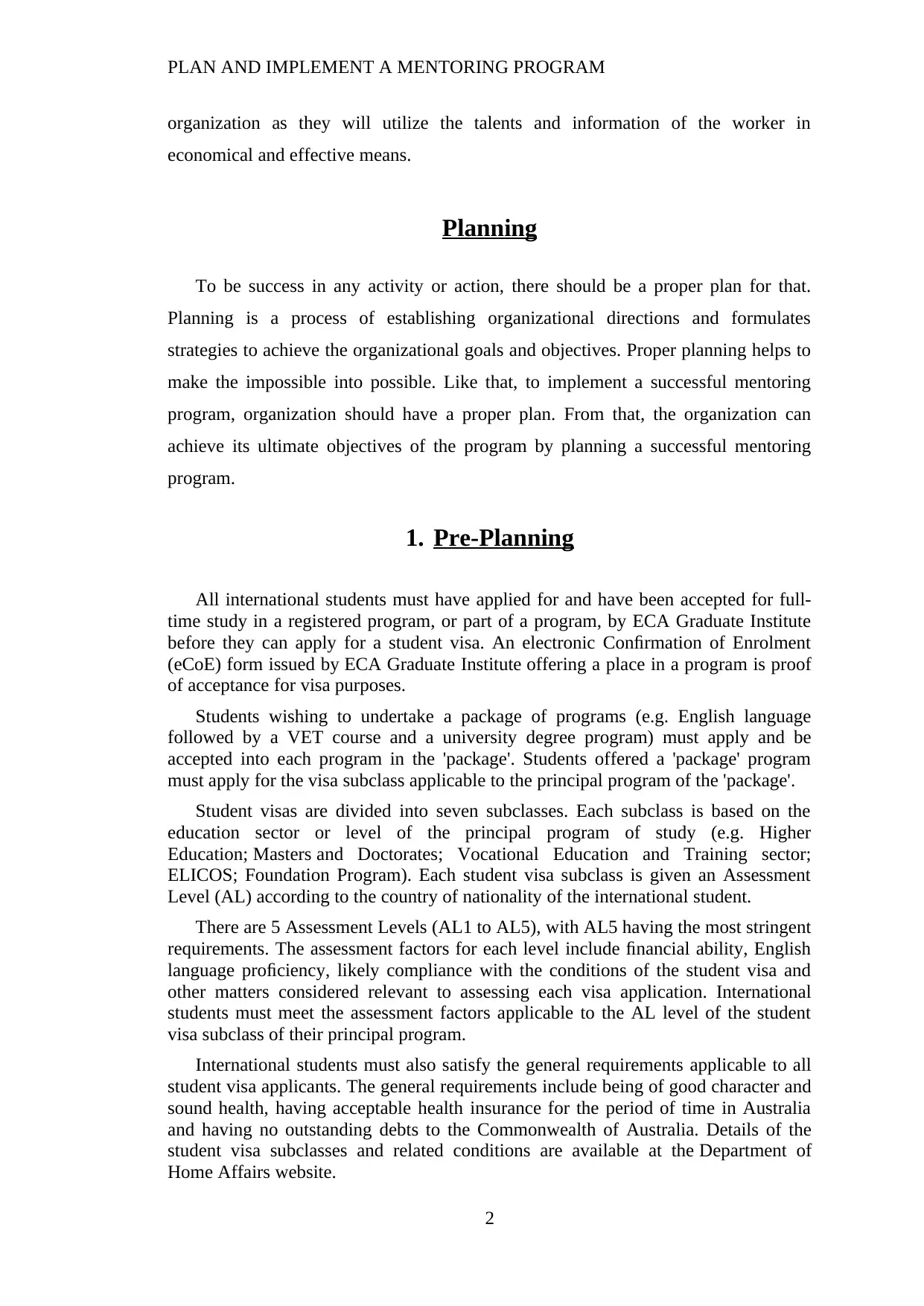
PLAN AND IMPLEMENT A MENTORING PROGRAM
organization as they will utilize the talents and information of the worker in
economical and effective means.
Planning
To be success in any activity or action, there should be a proper plan for that.
Planning is a process of establishing organizational directions and formulates
strategies to achieve the organizational goals and objectives. Proper planning helps to
make the impossible into possible. Like that, to implement a successful mentoring
program, organization should have a proper plan. From that, the organization can
achieve its ultimate objectives of the program by planning a successful mentoring
program.
1. Pre-Planning
All international students must have applied for and have been accepted for full-
time study in a registered program, or part of a program, by ECA Graduate Institute
before they can apply for a student visa. An electronic Confirmation of Enrolment
(eCoE) form issued by ECA Graduate Institute offering a place in a program is proof
of acceptance for visa purposes.
Students wishing to undertake a package of programs (e.g. English language
followed by a VET course and a university degree program) must apply and be
accepted into each program in the 'package'. Students offered a 'package' program
must apply for the visa subclass applicable to the principal program of the 'package'.
Student visas are divided into seven subclasses. Each subclass is based on the
education sector or level of the principal program of study (e.g. Higher
Education; Masters and Doctorates; Vocational Education and Training sector;
ELICOS; Foundation Program). Each student visa subclass is given an Assessment
Level (AL) according to the country of nationality of the international student.
There are 5 Assessment Levels (AL1 to AL5), with AL5 having the most stringent
requirements. The assessment factors for each level include financial ability, English
language proficiency, likely compliance with the conditions of the student visa and
other matters considered relevant to assessing each visa application. International
students must meet the assessment factors applicable to the AL level of the student
visa subclass of their principal program.
International students must also satisfy the general requirements applicable to all
student visa applicants. The general requirements include being of good character and
sound health, having acceptable health insurance for the period of time in Australia
and having no outstanding debts to the Commonwealth of Australia. Details of the
student visa subclasses and related conditions are available at the Department of
Home Affairs website.
2
organization as they will utilize the talents and information of the worker in
economical and effective means.
Planning
To be success in any activity or action, there should be a proper plan for that.
Planning is a process of establishing organizational directions and formulates
strategies to achieve the organizational goals and objectives. Proper planning helps to
make the impossible into possible. Like that, to implement a successful mentoring
program, organization should have a proper plan. From that, the organization can
achieve its ultimate objectives of the program by planning a successful mentoring
program.
1. Pre-Planning
All international students must have applied for and have been accepted for full-
time study in a registered program, or part of a program, by ECA Graduate Institute
before they can apply for a student visa. An electronic Confirmation of Enrolment
(eCoE) form issued by ECA Graduate Institute offering a place in a program is proof
of acceptance for visa purposes.
Students wishing to undertake a package of programs (e.g. English language
followed by a VET course and a university degree program) must apply and be
accepted into each program in the 'package'. Students offered a 'package' program
must apply for the visa subclass applicable to the principal program of the 'package'.
Student visas are divided into seven subclasses. Each subclass is based on the
education sector or level of the principal program of study (e.g. Higher
Education; Masters and Doctorates; Vocational Education and Training sector;
ELICOS; Foundation Program). Each student visa subclass is given an Assessment
Level (AL) according to the country of nationality of the international student.
There are 5 Assessment Levels (AL1 to AL5), with AL5 having the most stringent
requirements. The assessment factors for each level include financial ability, English
language proficiency, likely compliance with the conditions of the student visa and
other matters considered relevant to assessing each visa application. International
students must meet the assessment factors applicable to the AL level of the student
visa subclass of their principal program.
International students must also satisfy the general requirements applicable to all
student visa applicants. The general requirements include being of good character and
sound health, having acceptable health insurance for the period of time in Australia
and having no outstanding debts to the Commonwealth of Australia. Details of the
student visa subclasses and related conditions are available at the Department of
Home Affairs website.
2
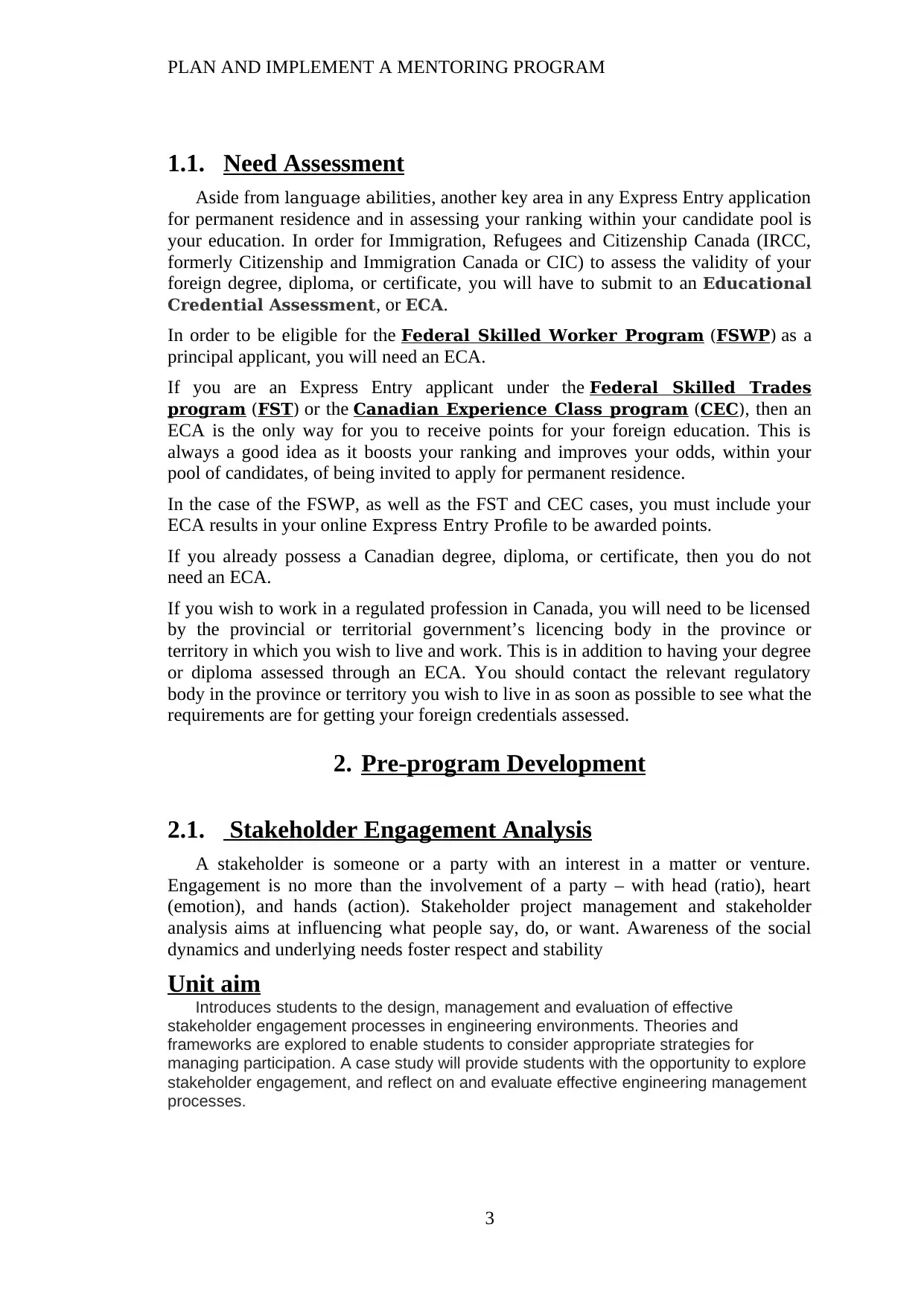
PLAN AND IMPLEMENT A MENTORING PROGRAM
1.1. Need Assessment
Aside from language abilities, another key area in any Express Entry application
for permanent residence and in assessing your ranking within your candidate pool is
your education. In order for Immigration, Refugees and Citizenship Canada (IRCC,
formerly Citizenship and Immigration Canada or CIC) to assess the validity of your
foreign degree, diploma, or certificate, you will have to submit to an Educational
Credential Assessment, or ECA.
In order to be eligible for the Federal Skilled Worker Program (FSWP) as a
principal applicant, you will need an ECA.
If you are an Express Entry applicant under the Federal Skilled Trades
program (FST) or the Canadian Experience Class program (CEC), then an
ECA is the only way for you to receive points for your foreign education. This is
always a good idea as it boosts your ranking and improves your odds, within your
pool of candidates, of being invited to apply for permanent residence.
In the case of the FSWP, as well as the FST and CEC cases, you must include your
ECA results in your online Express Entry Profile to be awarded points.
If you already possess a Canadian degree, diploma, or certificate, then you do not
need an ECA.
If you wish to work in a regulated profession in Canada, you will need to be licensed
by the provincial or territorial government’s licencing body in the province or
territory in which you wish to live and work. This is in addition to having your degree
or diploma assessed through an ECA. You should contact the relevant regulatory
body in the province or territory you wish to live in as soon as possible to see what the
requirements are for getting your foreign credentials assessed.
2. Pre-program Development
2.1. Stakeholder Engagement Analysis
A stakeholder is someone or a party with an interest in a matter or venture.
Engagement is no more than the involvement of a party – with head (ratio), heart
(emotion), and hands (action). Stakeholder project management and stakeholder
analysis aims at influencing what people say, do, or want. Awareness of the social
dynamics and underlying needs foster respect and stability
Unit aim
Introduces students to the design, management and evaluation of effective
stakeholder engagement processes in engineering environments. Theories and
frameworks are explored to enable students to consider appropriate strategies for
managing participation. A case study will provide students with the opportunity to explore
stakeholder engagement, and reflect on and evaluate effective engineering management
processes.
3
1.1. Need Assessment
Aside from language abilities, another key area in any Express Entry application
for permanent residence and in assessing your ranking within your candidate pool is
your education. In order for Immigration, Refugees and Citizenship Canada (IRCC,
formerly Citizenship and Immigration Canada or CIC) to assess the validity of your
foreign degree, diploma, or certificate, you will have to submit to an Educational
Credential Assessment, or ECA.
In order to be eligible for the Federal Skilled Worker Program (FSWP) as a
principal applicant, you will need an ECA.
If you are an Express Entry applicant under the Federal Skilled Trades
program (FST) or the Canadian Experience Class program (CEC), then an
ECA is the only way for you to receive points for your foreign education. This is
always a good idea as it boosts your ranking and improves your odds, within your
pool of candidates, of being invited to apply for permanent residence.
In the case of the FSWP, as well as the FST and CEC cases, you must include your
ECA results in your online Express Entry Profile to be awarded points.
If you already possess a Canadian degree, diploma, or certificate, then you do not
need an ECA.
If you wish to work in a regulated profession in Canada, you will need to be licensed
by the provincial or territorial government’s licencing body in the province or
territory in which you wish to live and work. This is in addition to having your degree
or diploma assessed through an ECA. You should contact the relevant regulatory
body in the province or territory you wish to live in as soon as possible to see what the
requirements are for getting your foreign credentials assessed.
2. Pre-program Development
2.1. Stakeholder Engagement Analysis
A stakeholder is someone or a party with an interest in a matter or venture.
Engagement is no more than the involvement of a party – with head (ratio), heart
(emotion), and hands (action). Stakeholder project management and stakeholder
analysis aims at influencing what people say, do, or want. Awareness of the social
dynamics and underlying needs foster respect and stability
Unit aim
Introduces students to the design, management and evaluation of effective
stakeholder engagement processes in engineering environments. Theories and
frameworks are explored to enable students to consider appropriate strategies for
managing participation. A case study will provide students with the opportunity to explore
stakeholder engagement, and reflect on and evaluate effective engineering management
processes.
3
⊘ This is a preview!⊘
Do you want full access?
Subscribe today to unlock all pages.

Trusted by 1+ million students worldwide
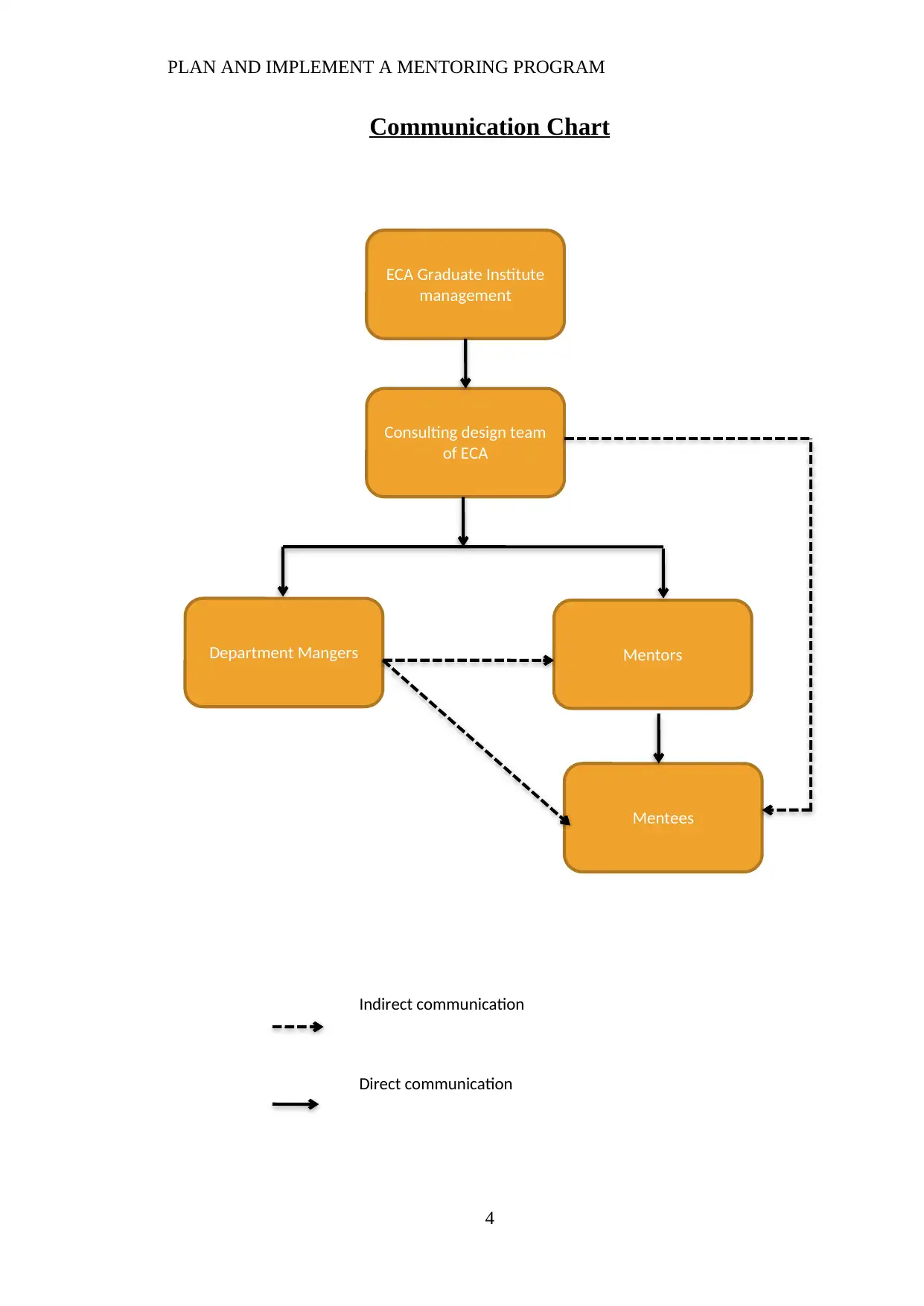
PLAN AND IMPLEMENT A MENTORING PROGRAM
Communication Chart
4
ECA Graduate Institute
management
Consulting design team
of ECA
Department Mangers Mentors
Mentees
Indirect communication
Direct communication
Communication Chart
4
ECA Graduate Institute
management
Consulting design team
of ECA
Department Mangers Mentors
Mentees
Indirect communication
Direct communication
Paraphrase This Document
Need a fresh take? Get an instant paraphrase of this document with our AI Paraphraser
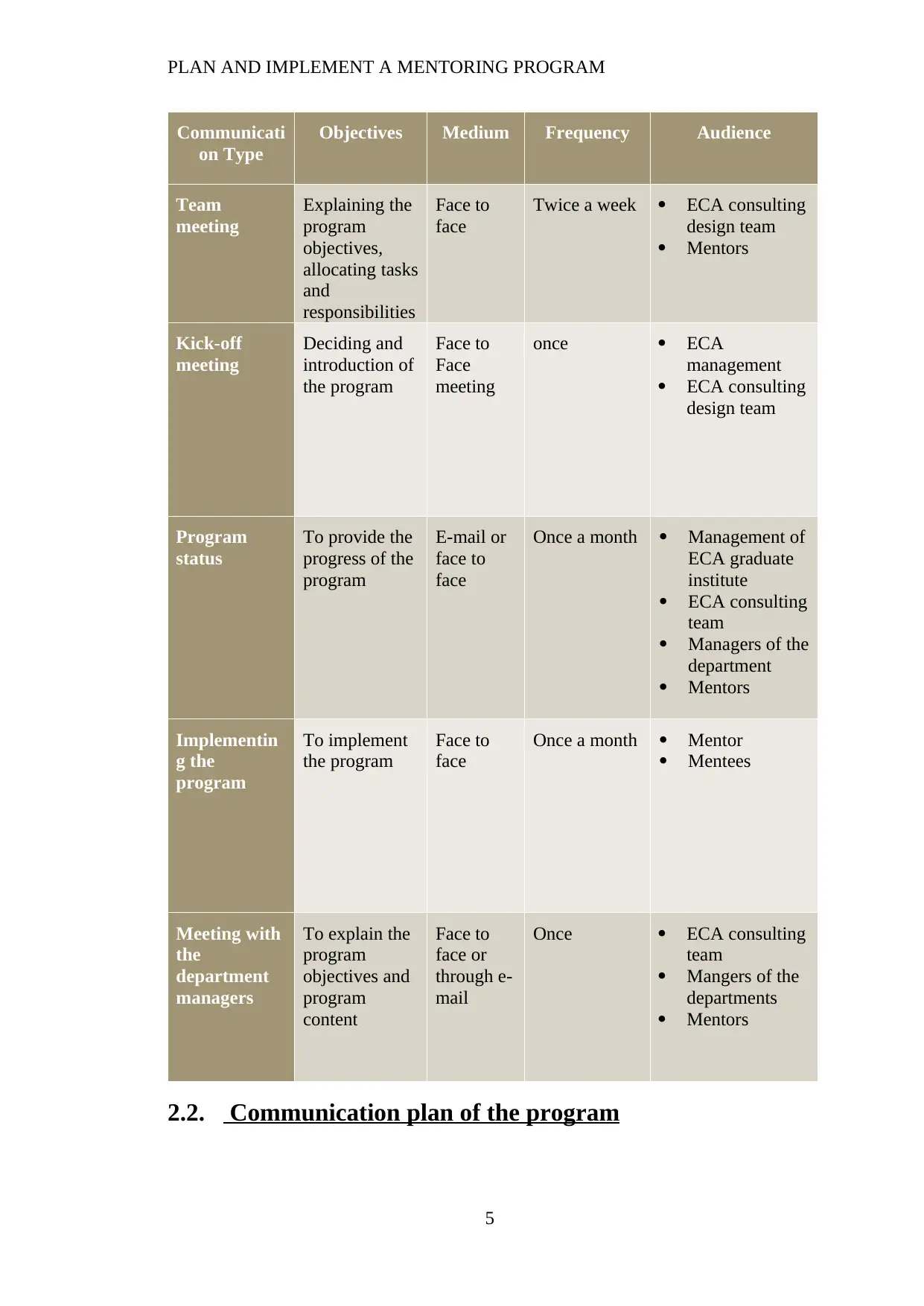
PLAN AND IMPLEMENT A MENTORING PROGRAM
Communicati
on Type
Objectives Medium Frequency Audience
Team
meeting
Explaining the
program
objectives,
allocating tasks
and
responsibilities
Face to
face
Twice a week ECA consulting
design team
Mentors
Kick-off
meeting
Deciding and
introduction of
the program
Face to
Face
meeting
once ECA
management
ECA consulting
design team
Program
status
To provide the
progress of the
program
E-mail or
face to
face
Once a month Management of
ECA graduate
institute
ECA consulting
team
Managers of the
department
Mentors
Implementin
g the
program
To implement
the program
Face to
face
Once a month Mentor
Mentees
Meeting with
the
department
managers
To explain the
program
objectives and
program
content
Face to
face or
through e-
mail
Once ECA consulting
team
Mangers of the
departments
Mentors
2.2. Communication plan of the program
5
Communicati
on Type
Objectives Medium Frequency Audience
Team
meeting
Explaining the
program
objectives,
allocating tasks
and
responsibilities
Face to
face
Twice a week ECA consulting
design team
Mentors
Kick-off
meeting
Deciding and
introduction of
the program
Face to
Face
meeting
once ECA
management
ECA consulting
design team
Program
status
To provide the
progress of the
program
E-mail or
face to
face
Once a month Management of
ECA graduate
institute
ECA consulting
team
Managers of the
department
Mentors
Implementin
g the
program
To implement
the program
Face to
face
Once a month Mentor
Mentees
Meeting with
the
department
managers
To explain the
program
objectives and
program
content
Face to
face or
through e-
Once ECA consulting
team
Mangers of the
departments
Mentors
2.2. Communication plan of the program
5
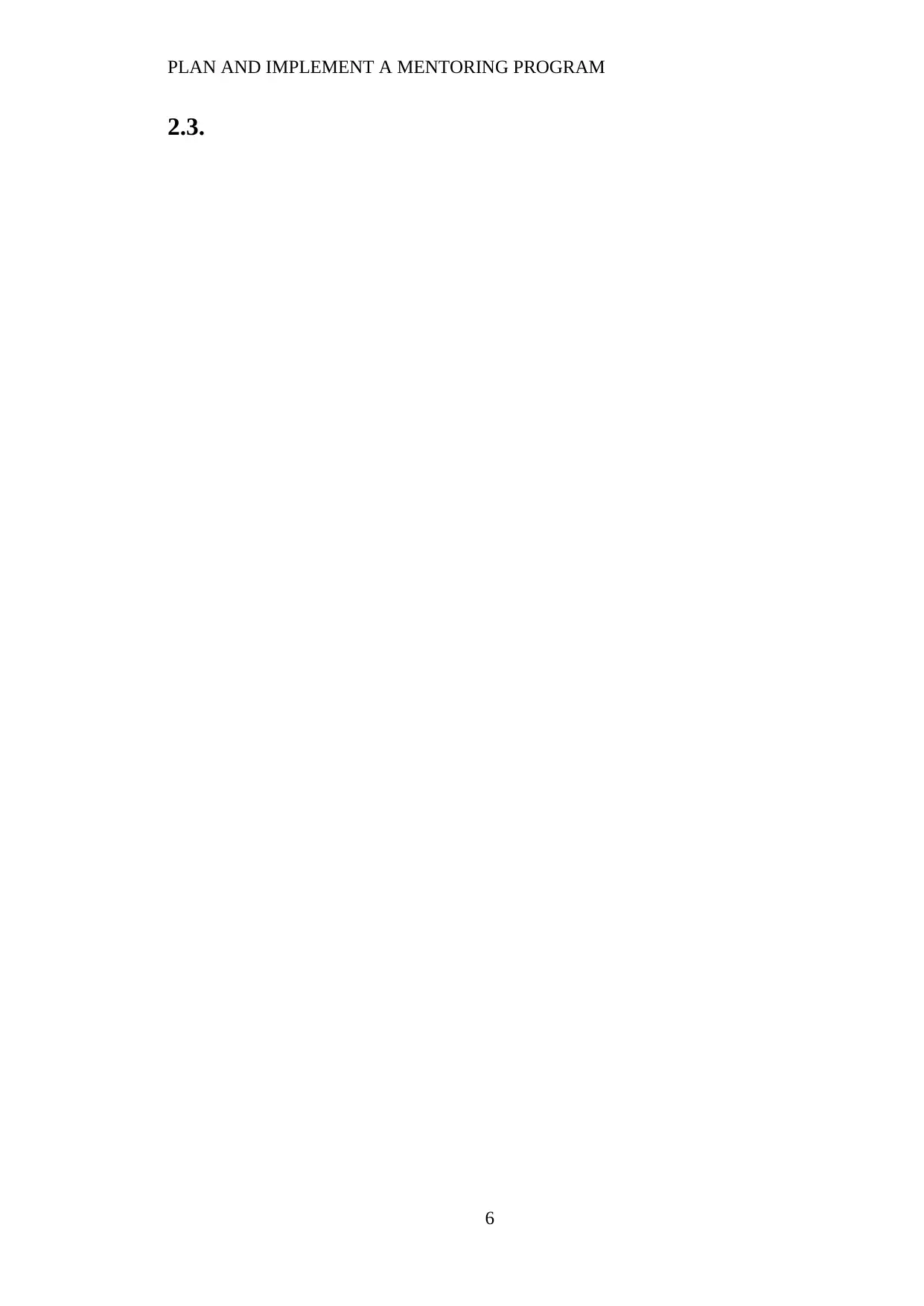
PLAN AND IMPLEMENT A MENTORING PROGRAM
2.3.
6
2.3.
6
⊘ This is a preview!⊘
Do you want full access?
Subscribe today to unlock all pages.

Trusted by 1+ million students worldwide
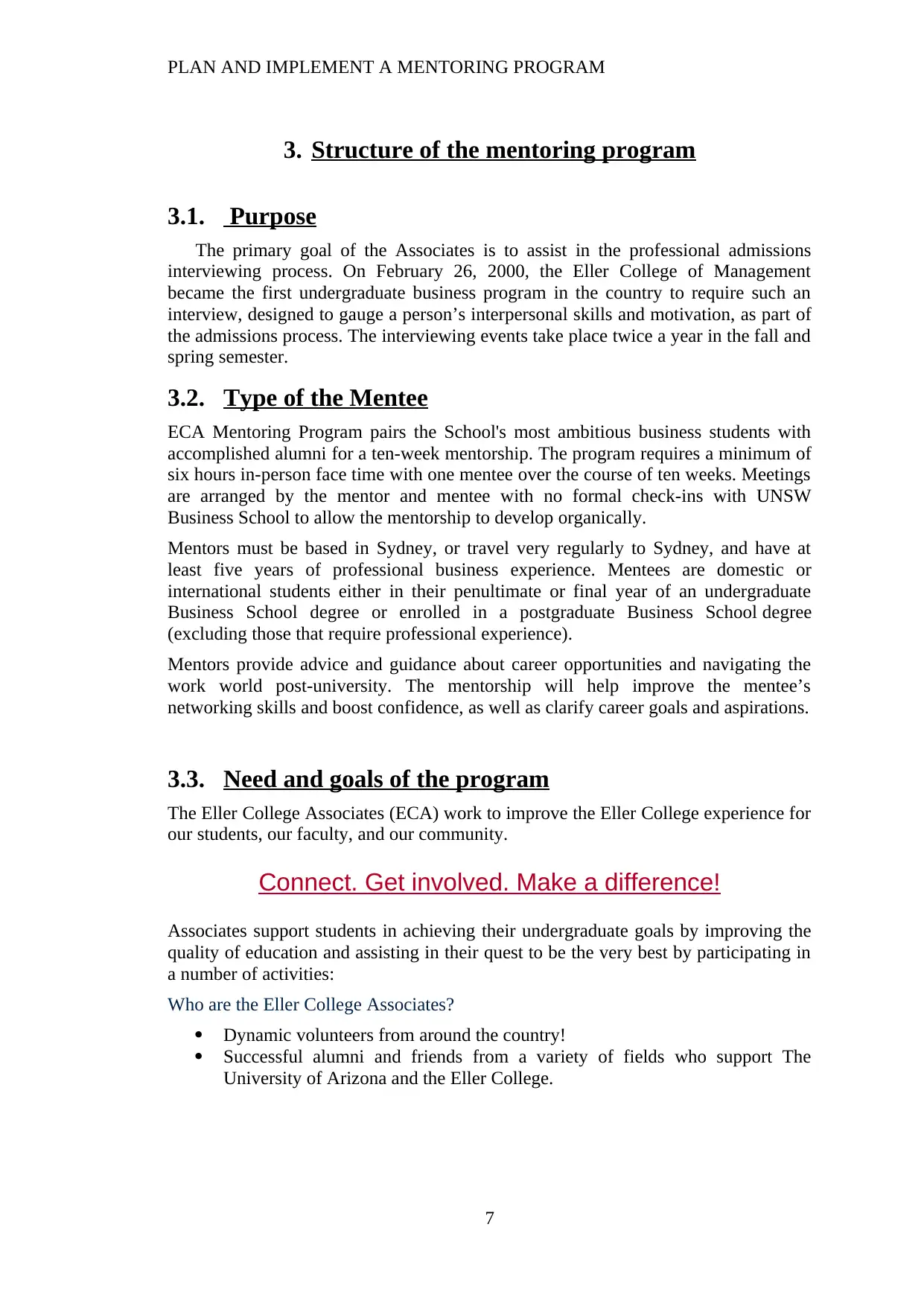
PLAN AND IMPLEMENT A MENTORING PROGRAM
3. Structure of the mentoring program
3.1. Purpose
The primary goal of the Associates is to assist in the professional admissions
interviewing process. On February 26, 2000, the Eller College of Management
became the first undergraduate business program in the country to require such an
interview, designed to gauge a person’s interpersonal skills and motivation, as part of
the admissions process. The interviewing events take place twice a year in the fall and
spring semester.
3.2. Type of the Mentee
ECA Mentoring Program pairs the School's most ambitious business students with
accomplished alumni for a ten-week mentorship. The program requires a minimum of
six hours in-person face time with one mentee over the course of ten weeks. Meetings
are arranged by the mentor and mentee with no formal check-ins with UNSW
Business School to allow the mentorship to develop organically.
Mentors must be based in Sydney, or travel very regularly to Sydney, and have at
least five years of professional business experience. Mentees are domestic or
international students either in their penultimate or final year of an undergraduate
Business School degree or enrolled in a postgraduate Business School degree
(excluding those that require professional experience).
Mentors provide advice and guidance about career opportunities and navigating the
work world post-university. The mentorship will help improve the mentee’s
networking skills and boost confidence, as well as clarify career goals and aspirations.
3.3. Need and goals of the program
The Eller College Associates (ECA) work to improve the Eller College experience for
our students, our faculty, and our community.
Connect. Get involved. Make a difference!
Associates support students in achieving their undergraduate goals by improving the
quality of education and assisting in their quest to be the very best by participating in
a number of activities:
Who are the Eller College Associates?
Dynamic volunteers from around the country!
Successful alumni and friends from a variety of fields who support The
University of Arizona and the Eller College.
7
3. Structure of the mentoring program
3.1. Purpose
The primary goal of the Associates is to assist in the professional admissions
interviewing process. On February 26, 2000, the Eller College of Management
became the first undergraduate business program in the country to require such an
interview, designed to gauge a person’s interpersonal skills and motivation, as part of
the admissions process. The interviewing events take place twice a year in the fall and
spring semester.
3.2. Type of the Mentee
ECA Mentoring Program pairs the School's most ambitious business students with
accomplished alumni for a ten-week mentorship. The program requires a minimum of
six hours in-person face time with one mentee over the course of ten weeks. Meetings
are arranged by the mentor and mentee with no formal check-ins with UNSW
Business School to allow the mentorship to develop organically.
Mentors must be based in Sydney, or travel very regularly to Sydney, and have at
least five years of professional business experience. Mentees are domestic or
international students either in their penultimate or final year of an undergraduate
Business School degree or enrolled in a postgraduate Business School degree
(excluding those that require professional experience).
Mentors provide advice and guidance about career opportunities and navigating the
work world post-university. The mentorship will help improve the mentee’s
networking skills and boost confidence, as well as clarify career goals and aspirations.
3.3. Need and goals of the program
The Eller College Associates (ECA) work to improve the Eller College experience for
our students, our faculty, and our community.
Connect. Get involved. Make a difference!
Associates support students in achieving their undergraduate goals by improving the
quality of education and assisting in their quest to be the very best by participating in
a number of activities:
Who are the Eller College Associates?
Dynamic volunteers from around the country!
Successful alumni and friends from a variety of fields who support The
University of Arizona and the Eller College.
7
Paraphrase This Document
Need a fresh take? Get an instant paraphrase of this document with our AI Paraphraser
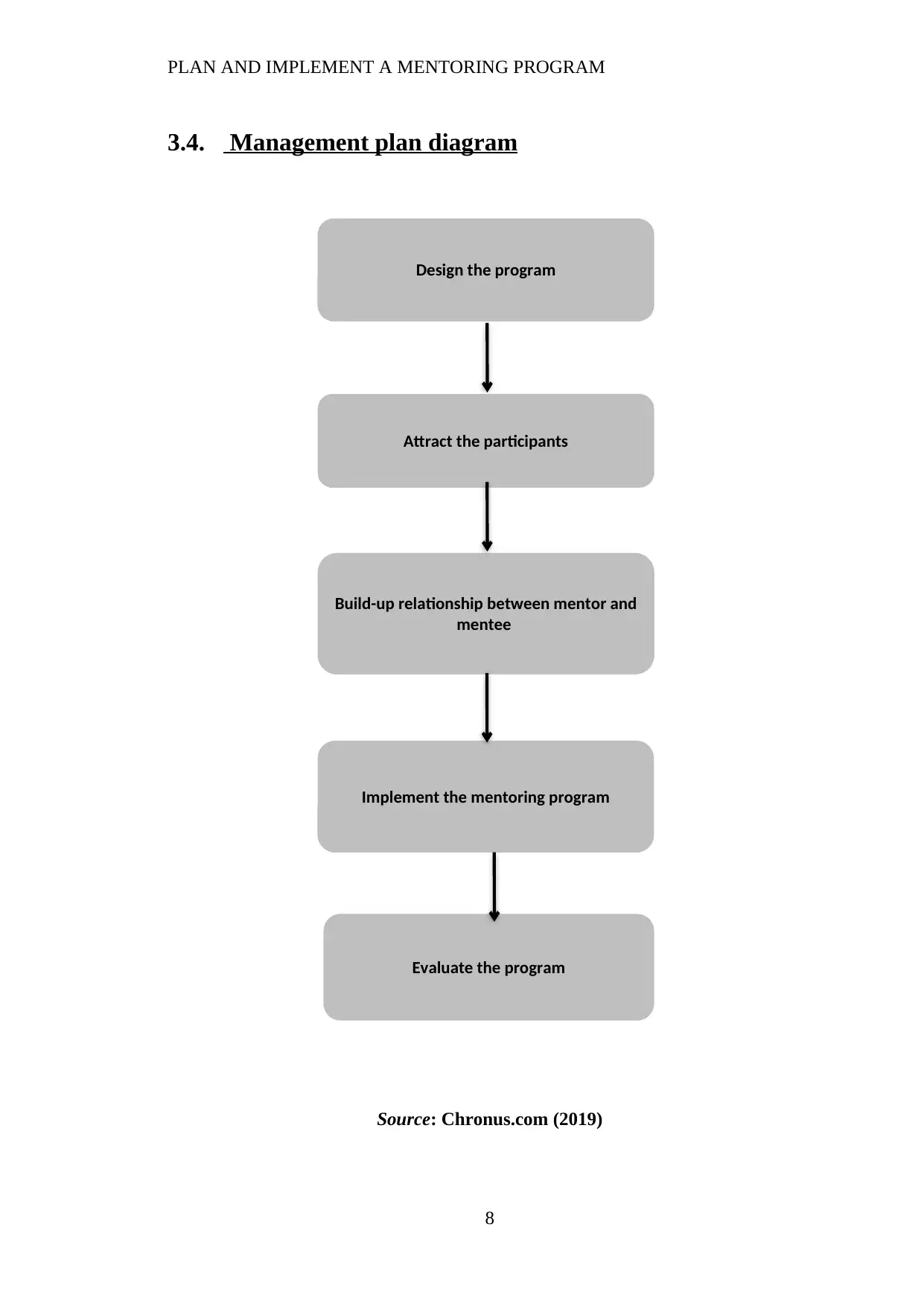
PLAN AND IMPLEMENT A MENTORING PROGRAM
3.4. Management plan diagram
Source: Chronus.com (2019)
8
Design the program
Attract the participants
Build-up relationship between mentor and
mentee
Implement the mentoring program
Evaluate the program
3.4. Management plan diagram
Source: Chronus.com (2019)
8
Design the program
Attract the participants
Build-up relationship between mentor and
mentee
Implement the mentoring program
Evaluate the program
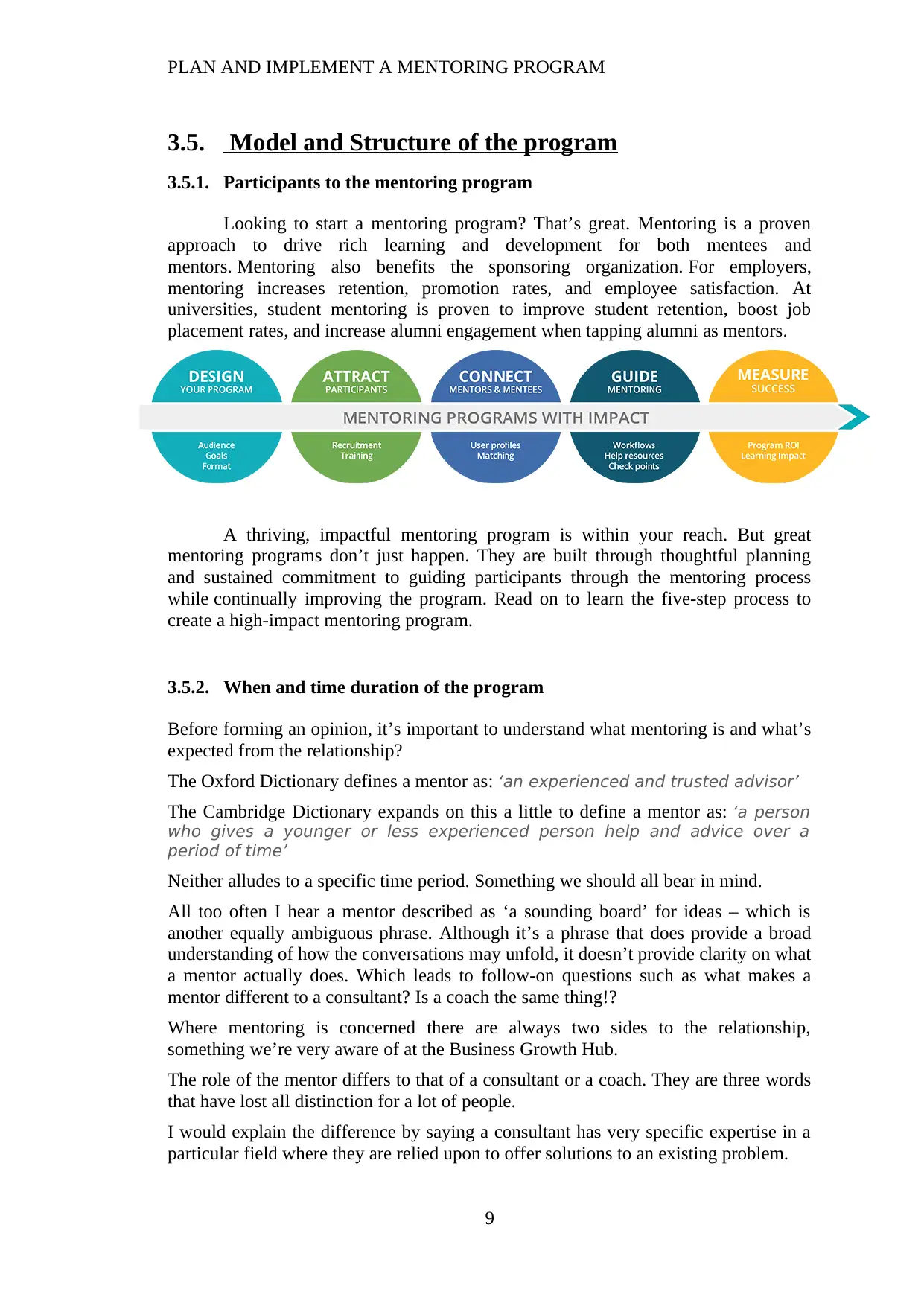
PLAN AND IMPLEMENT A MENTORING PROGRAM
3.5. Model and Structure of the program
3.5.1. Participants to the mentoring program
Looking to start a mentoring program? That’s great. Mentoring is a proven
approach to drive rich learning and development for both mentees and
mentors. Mentoring also benefits the sponsoring organization. For employers,
mentoring increases retention, promotion rates, and employee satisfaction. At
universities, student mentoring is proven to improve student retention, boost job
placement rates, and increase alumni engagement when tapping alumni as mentors.
A thriving, impactful mentoring program is within your reach. But great
mentoring programs don’t just happen. They are built through thoughtful planning
and sustained commitment to guiding participants through the mentoring process
while continually improving the program. Read on to learn the five-step process to
create a high-impact mentoring program.
3.5.2. When and time duration of the program
Before forming an opinion, it’s important to understand what mentoring is and what’s
expected from the relationship?
The Oxford Dictionary defines a mentor as: ‘an experienced and trusted advisor’
The Cambridge Dictionary expands on this a little to define a mentor as: ‘a person
who gives a younger or less experienced person help and advice over a
period of time’
Neither alludes to a specific time period. Something we should all bear in mind.
All too often I hear a mentor described as ‘a sounding board’ for ideas – which is
another equally ambiguous phrase. Although it’s a phrase that does provide a broad
understanding of how the conversations may unfold, it doesn’t provide clarity on what
a mentor actually does. Which leads to follow-on questions such as what makes a
mentor different to a consultant? Is a coach the same thing!?
Where mentoring is concerned there are always two sides to the relationship,
something we’re very aware of at the Business Growth Hub.
The role of the mentor differs to that of a consultant or a coach. They are three words
that have lost all distinction for a lot of people.
I would explain the difference by saying a consultant has very specific expertise in a
particular field where they are relied upon to offer solutions to an existing problem.
9
3.5. Model and Structure of the program
3.5.1. Participants to the mentoring program
Looking to start a mentoring program? That’s great. Mentoring is a proven
approach to drive rich learning and development for both mentees and
mentors. Mentoring also benefits the sponsoring organization. For employers,
mentoring increases retention, promotion rates, and employee satisfaction. At
universities, student mentoring is proven to improve student retention, boost job
placement rates, and increase alumni engagement when tapping alumni as mentors.
A thriving, impactful mentoring program is within your reach. But great
mentoring programs don’t just happen. They are built through thoughtful planning
and sustained commitment to guiding participants through the mentoring process
while continually improving the program. Read on to learn the five-step process to
create a high-impact mentoring program.
3.5.2. When and time duration of the program
Before forming an opinion, it’s important to understand what mentoring is and what’s
expected from the relationship?
The Oxford Dictionary defines a mentor as: ‘an experienced and trusted advisor’
The Cambridge Dictionary expands on this a little to define a mentor as: ‘a person
who gives a younger or less experienced person help and advice over a
period of time’
Neither alludes to a specific time period. Something we should all bear in mind.
All too often I hear a mentor described as ‘a sounding board’ for ideas – which is
another equally ambiguous phrase. Although it’s a phrase that does provide a broad
understanding of how the conversations may unfold, it doesn’t provide clarity on what
a mentor actually does. Which leads to follow-on questions such as what makes a
mentor different to a consultant? Is a coach the same thing!?
Where mentoring is concerned there are always two sides to the relationship,
something we’re very aware of at the Business Growth Hub.
The role of the mentor differs to that of a consultant or a coach. They are three words
that have lost all distinction for a lot of people.
I would explain the difference by saying a consultant has very specific expertise in a
particular field where they are relied upon to offer solutions to an existing problem.
9
⊘ This is a preview!⊘
Do you want full access?
Subscribe today to unlock all pages.

Trusted by 1+ million students worldwide
1 out of 40
Related Documents
Your All-in-One AI-Powered Toolkit for Academic Success.
+13062052269
info@desklib.com
Available 24*7 on WhatsApp / Email
![[object Object]](/_next/static/media/star-bottom.7253800d.svg)
Unlock your academic potential
Copyright © 2020–2025 A2Z Services. All Rights Reserved. Developed and managed by ZUCOL.




